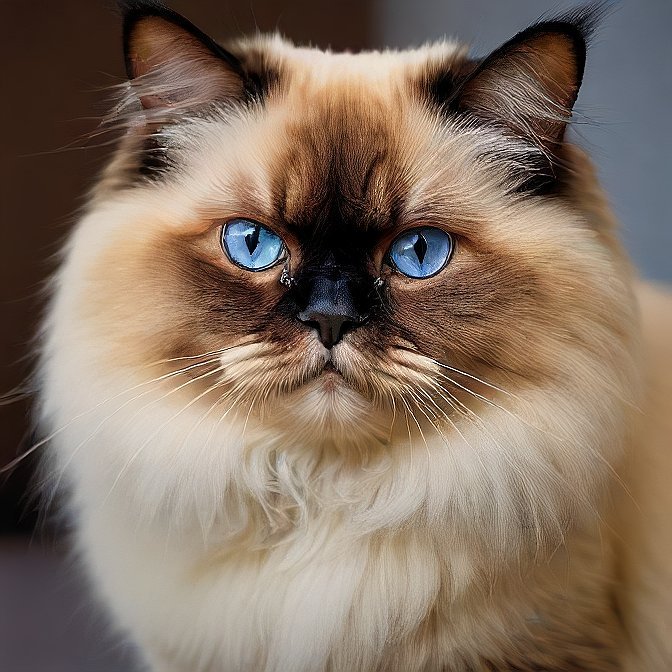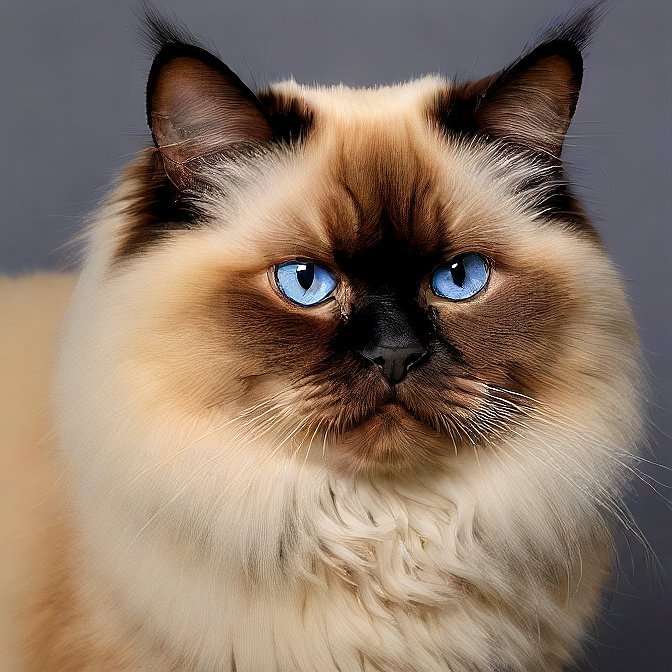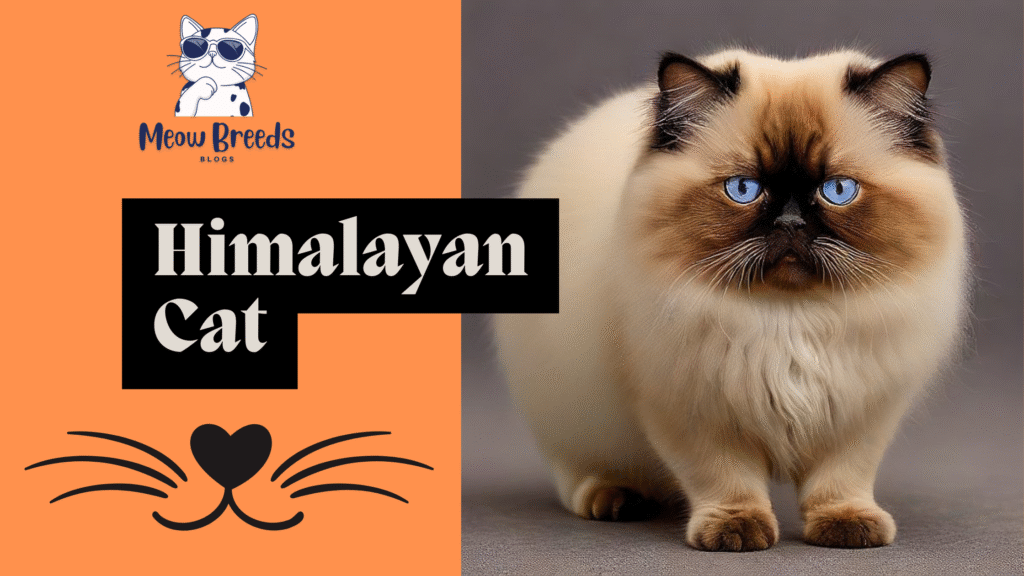Table of Contents
Introduction
Himalayan cat breed is eye candy to every person who loves cats due to its luxurious furry coat, blue eyes and its very sweet disposition. The Himalayan is said as the best of both worlds by being a cross between the majestic long-haired frame of the Persian and the color-point pattern and bright eye colour of the Siamese. These beautiful cats are also admired by their beauty and calm behavior and adorable characters that adore their owners and keep them close and that is why this breed has become so popular among the lovers who need the warm company.

As a new cat owner or an experienced cat lover, getting to understand more about the Himalayan cat would assist you make a decision on whether this royal-looking cat is suitable in your home or not.
Origins and History of the Himalayan Cat
Himalayan is a rather new breed, which has an interesting history of emergence that starts at the beginning of 20th century. United States and United Kingdom breeders wanted to achieve a cat that had the long luxurious hair of the Persian and the beautiful blue eyes and point coloring of the Siamese.
Early Breeding Efforts
- Harvard breeders including Dr. Clyde Keeler and Virginia Cobb tested cross-breeding between the Siamese and Persian cats in the 1930s.
- They were interested in genetic aspect of the color and pattern of the coat, and the end result was beautiful cats in terms of looks and disposition.
Official Recognition
- Throughout the 1950s breeders had perfected the appearance of the Himalayan and it had become its own breed in the eyes of cat associations such as the Cat Fanciers Association (CFA) and The International Cat Association (TICA).
- The Himalayan is sometimes recognized as a distinct breed and in other records it is recorded as a color-point variety of the Persian.
Physical Characteristics of the Himalayan Cat
It is an easy mistake to make when distinguishing the Himalayan cat due to its plush look, which is composed of Persian fluff and the Siamese elegance. Such breed is distinguished by everything: by its soft fur, impressive blue eyes, etc.
Size and Build
- Size: Medium to large
- Weight: Typically between 7 to 12 pounds
- Build: Sturdy and cobby, with a short, thick neck and broad chest
- Head: Round and massive with full cheeks
Coat and Colors
- Coat: Long, dense, and silky. Daily grooming is essential to prevent tangles and mats.
- Colors: Himalayans are known for their “pointed” color patterns — darker coloration on the ears, face, paws, and tail, similar to the Siamese.
- Common color points include:
- Seal
- Blue
- Chocolate
- Lilac
- Flame (red)
- Cream
- Tortie (tortoiseshell)
- Lynx (tabby-like markings)
Eyes
- Color: Always a vivid, deep blue — one of the breed’s most striking features.
Personality and Temperament
The Himalayan is not only superficial. The reason they are getting so popular as pets is their temperament.
Key Personality Traits
- Affectionate: Himalayan have a very strong affection towards their humans. They are also described as friendly lap cats which enjoy cuddling up.
- Calm and Quiet: Unlike vocal Siamese, the Himalayans are more soft spoken. They can talk in a meow or purring.
- Intelligent: hey are smart and love interactive toys and games that is mentally stimulating.
- People-Oriented: They are not usually demanding but they rather stay around the people under whom they belong and hate staying long without them.
- Adaptable: Himalayans tend to adapt in home settings and are suitable to be kept in apartments since they are docile.
Grooming and Maintenance

Being a Himalayan owner, it has a responsibility particularly in terms of grooming. Their luxuriant and hanging coat must be kept in good condition by frequent grooming which helps in their beauty as well as in avoiding health related problems.
Daily Grooming
- Brushing: It is necessary to brush every day in order to prevent snarls and mats. Apply a soft brush with wide toothed comb.
- Eye Cleaning: Himalayans are very prone to getting too much stain in the eyes so cleaning the eyes is critical. The area around the eyes should be wiped off softly with a wet washcloth once a day.
- Bathing: giving them a bath once every month also enables them to maintain a clean coat by eliminating excess oil. Apply cat friendly smooth shampoo.
- Nail Trimming: Trim the nails regularly after every two weeks to prevent overgrowing and entangling of the nails.
- Ear Cleaning: Clean the ears to ensure there is no dirt, wax or absorption of infection once a week.
Litter Box Maintenance
Himalayans are very particular about cleanliness. Keep their litter box clean, or they may refuse to use it.
Diet and Nutrition
Himalayans are scrupulous as far as cleanliness is concerned. Have a clean litter box otherwise they will not use it.
Feeding Tips
- High-Quality Food: Feed your cat food of high quality; low in fillers and high in protein.
- Balanced Diet: The food should be able to fulfill all the nutritional demands, including taurine, essential fatty acids, and Vitamins.
- Weight Control: The Himalayans are prone to obesity, hence, one should not over-feed or watch in the size of the portions.
- Hydration: They include hydration i.e. encourage fluid intake (water) and it might be possible to include wet food in the diet as such this helps maintain the health of the kidney.
Check Out: Havana Brown Cat – Breed#16.
Health and Common Medical Issues
Although Himalayan is usually a healthy long-lived breed, it has some inherited and breed-specific health problems.
Common Health Concerns
- Polycystic Kidney Disease (PKD): A genetic diseases frequently occurring in Persians and Himalayans. This is screened in reputable breeders.
- Respiratory Issues: They have flat (brachycephalic) faces which cause breathing problems and snoring.
- Eye Problems: They have a tendency of excessive tears, blocked tears duct and later infections, all because of the way they are structured in the face.
- Dental Issues: Dental health should be a regular affair to avoid problems of decayed teeth and gum diseases.
- Obesity: They are not the most active breed, and watch their weight.
Lifespan
Taken care of adequately, a Himalayan cat can live up to 12 years and even more. Assessing of vets and having good lifestyle contribute much to longevity.
Ideal Home Environment
Similar to the Boston Terriers, the Himalayan does well in a peaceful, loving environment where it could develop a close relationship with its human masters.
Best Fit For:
- Families (especially with older children)
- Singles or couples
- Seniors
- Cat owners who are home often or have other pets
Not Ideal For:
- Very young children who may handle them roughly
- Households where they’ll be left alone for long hours
- Owners who cannot commit to daily grooming
They do not like intensive surroundings and enjoy such nice places as sofas, beds, and warm places near a sunny window. Himalayans also prefer to live inside and they can live happier indoors as they have face docile nature and they may become either stolen or injured.
Training and Socialization
Himalayans are clever animals but not very fast learners of new tricks as they are not so active breeds, training requires a lot of patience and encouragement.
Socialization
Begin early, and be easy and uniform. Introduce them to other individuals, noises, and routines in order that they develop to be successful adults.
Litter Training
Himalayans tend to be simple to litter train, at least when the box is maintained in a very clean state.
Choosing a Himalayan Cat

Finding a Reputable Breeder
Since the breed is popular and has specific requirements, it is necessary to locate a good breeder who has the breed tested to eliminate hereditary conditions and kittens developed in a healthy and loving home.
Adoption
Not all the Himalayans end up in shelters or breed-specific rescues. A Himalayan or Himalayan mix adoption can be just the thing to find a loving home to a needy cat.
Conclusion
Himalayan cat is the magnificent blend of beauty, smartness and friendship. Bragging about a rich coat, gorgeous sapphire blue eyes and an amiability, it is not a miracle that breed has reached to the hearts of all cat owners all over the world.
But the reality is to keep behind the camera, to possess a Himalayan, is to guarantee daily grooming, maintenance in good health as well as spoonfoods of love. In exchange you will get a sweet, nurturing companion that will bring style and affection into your life over years.
The Himalayan may be an answer to a prayer, in case what you desire is a quiet, loving cat, who cherishes to curl up in your lap as much as it is acceptable to them to curl up a good deal into your face.
For more info: Click Here.
FAQs About Himalayan Cat
1. Are the Himalayan cats hypoallergenic?
No, Himalayan cats do not happen to be hypoallergenic. They have long fur and dander that can cause allergies hence they might not suit the victim of allergies.
2. How frequently do I have to groom a Himalayan?
The grooming should be done every day to avoid matting and tangling. They are easy to maintain and brush regularly and bathe occasionally to take care of their coat.
3. Do Himalayan cats get along with on other pets?
Yes, they tend to get along well with other cats and even dogs whether they are introduced slowly and are otherwise well socialized.



